Cost of Capital Analysis and WACC Calculation for Bad Boys, Inc.
VerifiedAdded on 2022/12/14
|6
|1091
|440
Homework Assignment
AI Summary
This financial management assignment analyzes the cost of capital for Bad Boys, Inc. The analysis includes calculating the weighted average cost of capital (WACC) under different capital structures. The assignment identifies the cost of capital for debt, preferred stock, and common stock, providing detailed calculations for each. It examines the impact of changes in the capital structure on the WACC, comparing scenarios with varying weights of debt, preferred stock, and common stock. The solution includes formulas and explanations for determining the after-tax cost of debt, the cost of preferred stock, and the cost of common stock, incorporating tax rates, dividends, market prices, and growth rates. The document highlights the importance of WACC in investment decisions and capital allocation, referencing relevant literature to support the analysis.
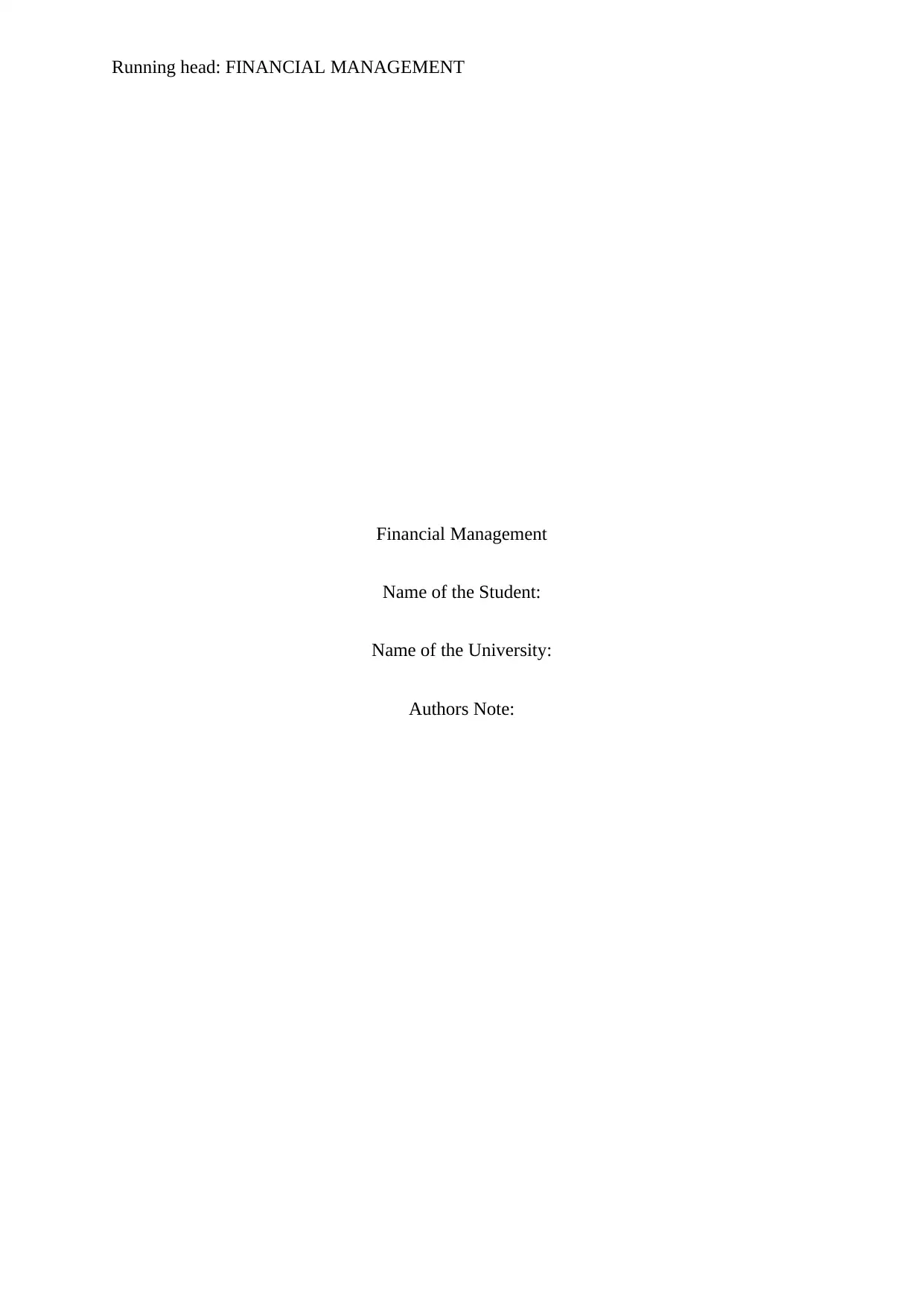
Running head: FINANCIAL MANAGEMENT
Financial Management
Name of the Student:
Name of the University:
Authors Note:
Financial Management
Name of the Student:
Name of the University:
Authors Note:
Paraphrase This Document
Need a fresh take? Get an instant paraphrase of this document with our AI Paraphraser
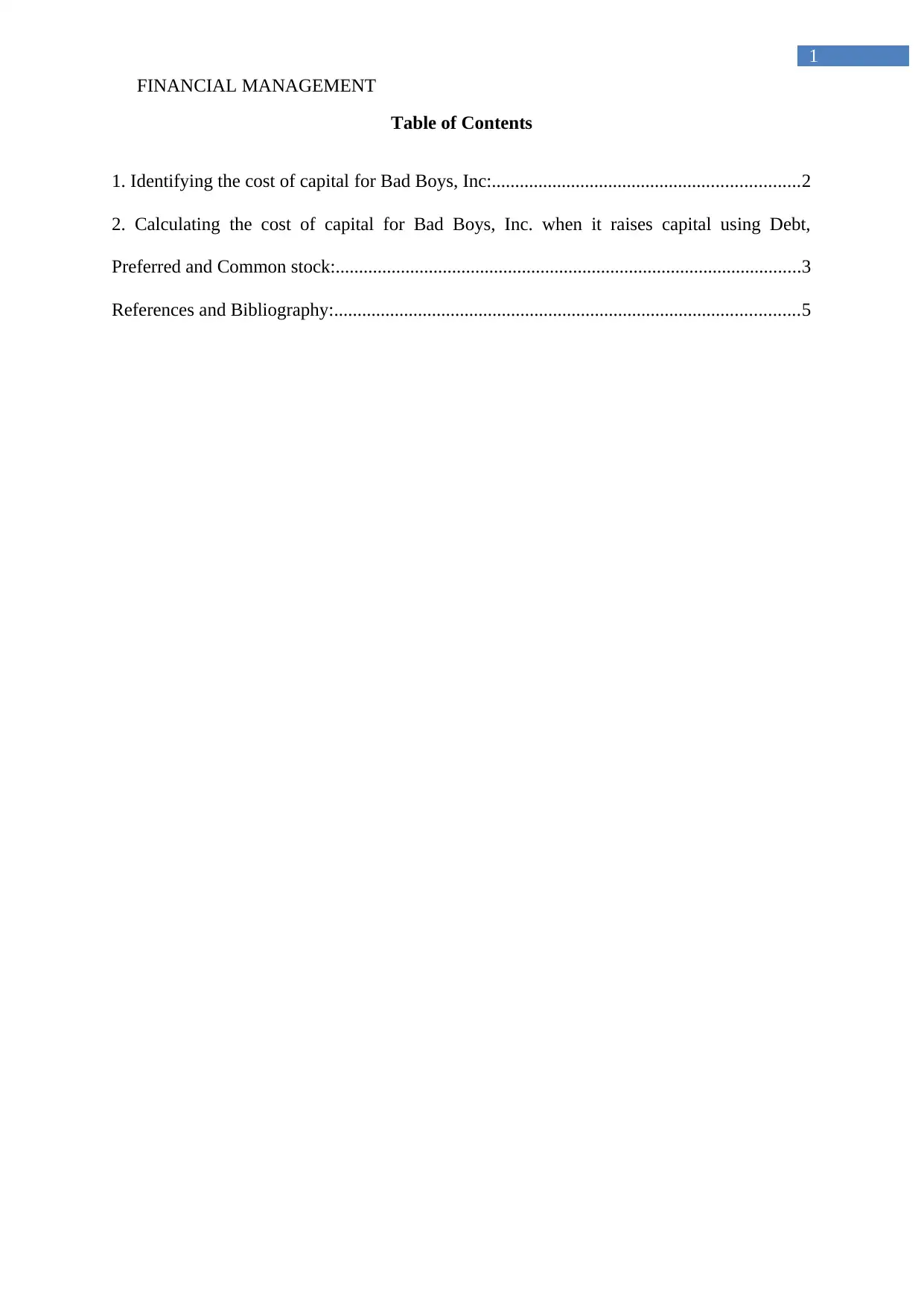
FINANCIAL MANAGEMENT
1
Table of Contents
1. Identifying the cost of capital for Bad Boys, Inc:..................................................................2
2. Calculating the cost of capital for Bad Boys, Inc. when it raises capital using Debt,
Preferred and Common stock:....................................................................................................3
References and Bibliography:....................................................................................................5
1
Table of Contents
1. Identifying the cost of capital for Bad Boys, Inc:..................................................................2
2. Calculating the cost of capital for Bad Boys, Inc. when it raises capital using Debt,
Preferred and Common stock:....................................................................................................3
References and Bibliography:....................................................................................................5
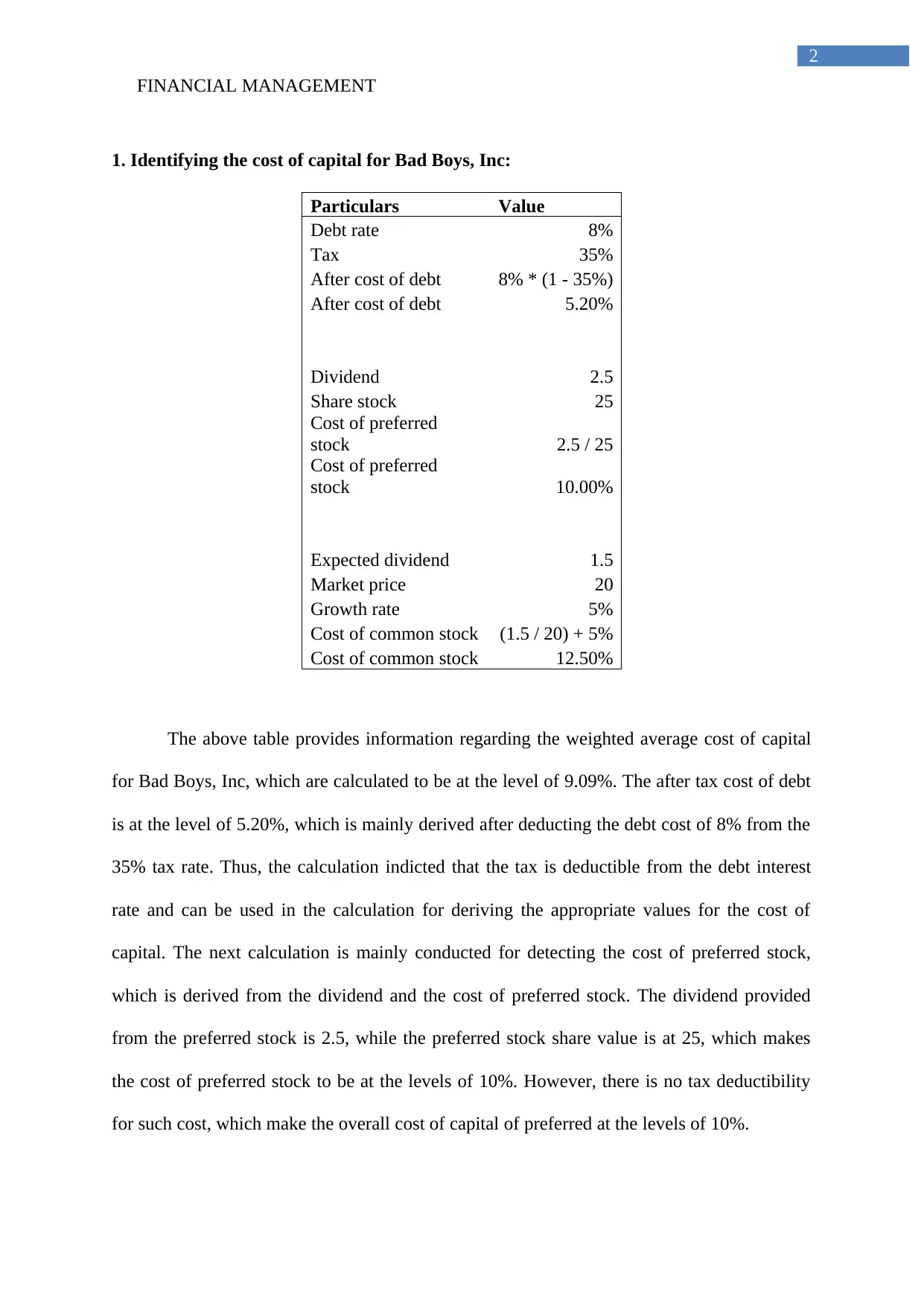
FINANCIAL MANAGEMENT
2
1. Identifying the cost of capital for Bad Boys, Inc:
Particulars Value
Debt rate 8%
Tax 35%
After cost of debt 8% * (1 - 35%)
After cost of debt 5.20%
Dividend 2.5
Share stock 25
Cost of preferred
stock 2.5 / 25
Cost of preferred
stock 10.00%
Expected dividend 1.5
Market price 20
Growth rate 5%
Cost of common stock (1.5 / 20) + 5%
Cost of common stock 12.50%
The above table provides information regarding the weighted average cost of capital
for Bad Boys, Inc, which are calculated to be at the level of 9.09%. The after tax cost of debt
is at the level of 5.20%, which is mainly derived after deducting the debt cost of 8% from the
35% tax rate. Thus, the calculation indicted that the tax is deductible from the debt interest
rate and can be used in the calculation for deriving the appropriate values for the cost of
capital. The next calculation is mainly conducted for detecting the cost of preferred stock,
which is derived from the dividend and the cost of preferred stock. The dividend provided
from the preferred stock is 2.5, while the preferred stock share value is at 25, which makes
the cost of preferred stock to be at the levels of 10%. However, there is no tax deductibility
for such cost, which make the overall cost of capital of preferred at the levels of 10%.
2
1. Identifying the cost of capital for Bad Boys, Inc:
Particulars Value
Debt rate 8%
Tax 35%
After cost of debt 8% * (1 - 35%)
After cost of debt 5.20%
Dividend 2.5
Share stock 25
Cost of preferred
stock 2.5 / 25
Cost of preferred
stock 10.00%
Expected dividend 1.5
Market price 20
Growth rate 5%
Cost of common stock (1.5 / 20) + 5%
Cost of common stock 12.50%
The above table provides information regarding the weighted average cost of capital
for Bad Boys, Inc, which are calculated to be at the level of 9.09%. The after tax cost of debt
is at the level of 5.20%, which is mainly derived after deducting the debt cost of 8% from the
35% tax rate. Thus, the calculation indicted that the tax is deductible from the debt interest
rate and can be used in the calculation for deriving the appropriate values for the cost of
capital. The next calculation is mainly conducted for detecting the cost of preferred stock,
which is derived from the dividend and the cost of preferred stock. The dividend provided
from the preferred stock is 2.5, while the preferred stock share value is at 25, which makes
the cost of preferred stock to be at the levels of 10%. However, there is no tax deductibility
for such cost, which make the overall cost of capital of preferred at the levels of 10%.
⊘ This is a preview!⊘
Do you want full access?
Subscribe today to unlock all pages.

Trusted by 1+ million students worldwide
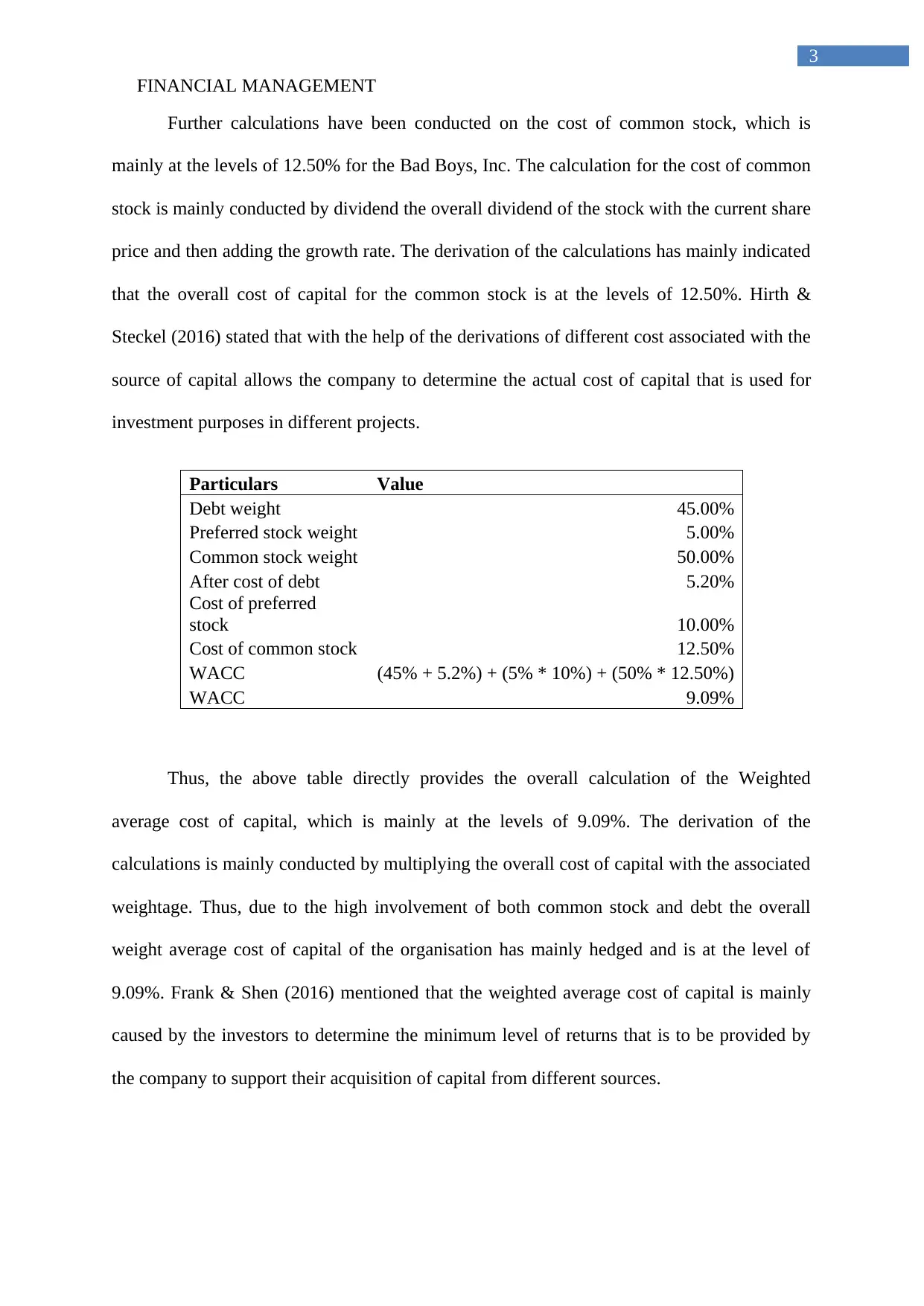
FINANCIAL MANAGEMENT
3
Further calculations have been conducted on the cost of common stock, which is
mainly at the levels of 12.50% for the Bad Boys, Inc. The calculation for the cost of common
stock is mainly conducted by dividend the overall dividend of the stock with the current share
price and then adding the growth rate. The derivation of the calculations has mainly indicated
that the overall cost of capital for the common stock is at the levels of 12.50%. Hirth &
Steckel (2016) stated that with the help of the derivations of different cost associated with the
source of capital allows the company to determine the actual cost of capital that is used for
investment purposes in different projects.
Particulars Value
Debt weight 45.00%
Preferred stock weight 5.00%
Common stock weight 50.00%
After cost of debt 5.20%
Cost of preferred
stock 10.00%
Cost of common stock 12.50%
WACC (45% + 5.2%) + (5% * 10%) + (50% * 12.50%)
WACC 9.09%
Thus, the above table directly provides the overall calculation of the Weighted
average cost of capital, which is mainly at the levels of 9.09%. The derivation of the
calculations is mainly conducted by multiplying the overall cost of capital with the associated
weightage. Thus, due to the high involvement of both common stock and debt the overall
weight average cost of capital of the organisation has mainly hedged and is at the level of
9.09%. Frank & Shen (2016) mentioned that the weighted average cost of capital is mainly
caused by the investors to determine the minimum level of returns that is to be provided by
the company to support their acquisition of capital from different sources.
3
Further calculations have been conducted on the cost of common stock, which is
mainly at the levels of 12.50% for the Bad Boys, Inc. The calculation for the cost of common
stock is mainly conducted by dividend the overall dividend of the stock with the current share
price and then adding the growth rate. The derivation of the calculations has mainly indicated
that the overall cost of capital for the common stock is at the levels of 12.50%. Hirth &
Steckel (2016) stated that with the help of the derivations of different cost associated with the
source of capital allows the company to determine the actual cost of capital that is used for
investment purposes in different projects.
Particulars Value
Debt weight 45.00%
Preferred stock weight 5.00%
Common stock weight 50.00%
After cost of debt 5.20%
Cost of preferred
stock 10.00%
Cost of common stock 12.50%
WACC (45% + 5.2%) + (5% * 10%) + (50% * 12.50%)
WACC 9.09%
Thus, the above table directly provides the overall calculation of the Weighted
average cost of capital, which is mainly at the levels of 9.09%. The derivation of the
calculations is mainly conducted by multiplying the overall cost of capital with the associated
weightage. Thus, due to the high involvement of both common stock and debt the overall
weight average cost of capital of the organisation has mainly hedged and is at the level of
9.09%. Frank & Shen (2016) mentioned that the weighted average cost of capital is mainly
caused by the investors to determine the minimum level of returns that is to be provided by
the company to support their acquisition of capital from different sources.
Paraphrase This Document
Need a fresh take? Get an instant paraphrase of this document with our AI Paraphraser
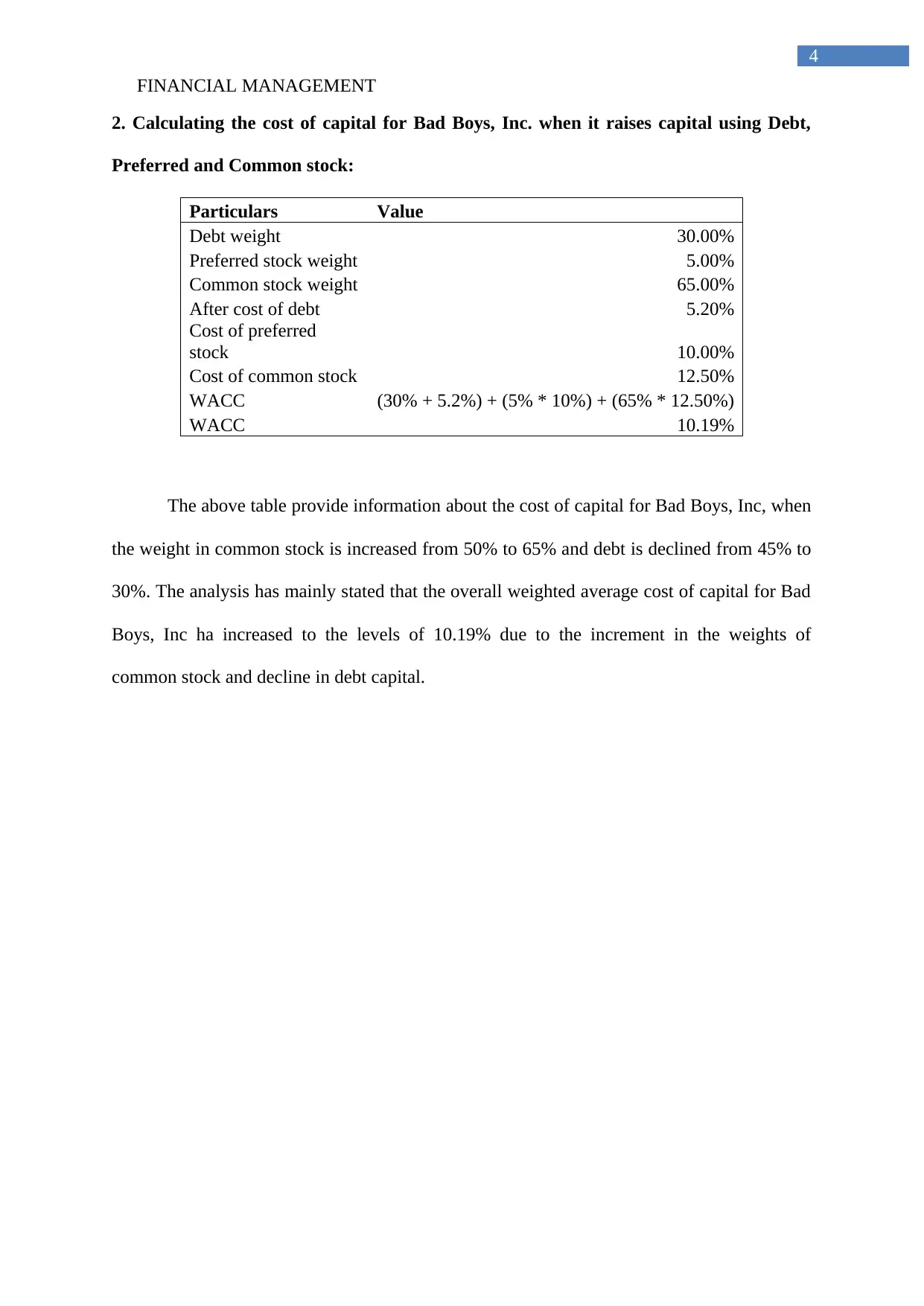
FINANCIAL MANAGEMENT
4
2. Calculating the cost of capital for Bad Boys, Inc. when it raises capital using Debt,
Preferred and Common stock:
Particulars Value
Debt weight 30.00%
Preferred stock weight 5.00%
Common stock weight 65.00%
After cost of debt 5.20%
Cost of preferred
stock 10.00%
Cost of common stock 12.50%
WACC (30% + 5.2%) + (5% * 10%) + (65% * 12.50%)
WACC 10.19%
The above table provide information about the cost of capital for Bad Boys, Inc, when
the weight in common stock is increased from 50% to 65% and debt is declined from 45% to
30%. The analysis has mainly stated that the overall weighted average cost of capital for Bad
Boys, Inc ha increased to the levels of 10.19% due to the increment in the weights of
common stock and decline in debt capital.
4
2. Calculating the cost of capital for Bad Boys, Inc. when it raises capital using Debt,
Preferred and Common stock:
Particulars Value
Debt weight 30.00%
Preferred stock weight 5.00%
Common stock weight 65.00%
After cost of debt 5.20%
Cost of preferred
stock 10.00%
Cost of common stock 12.50%
WACC (30% + 5.2%) + (5% * 10%) + (65% * 12.50%)
WACC 10.19%
The above table provide information about the cost of capital for Bad Boys, Inc, when
the weight in common stock is increased from 50% to 65% and debt is declined from 45% to
30%. The analysis has mainly stated that the overall weighted average cost of capital for Bad
Boys, Inc ha increased to the levels of 10.19% due to the increment in the weights of
common stock and decline in debt capital.
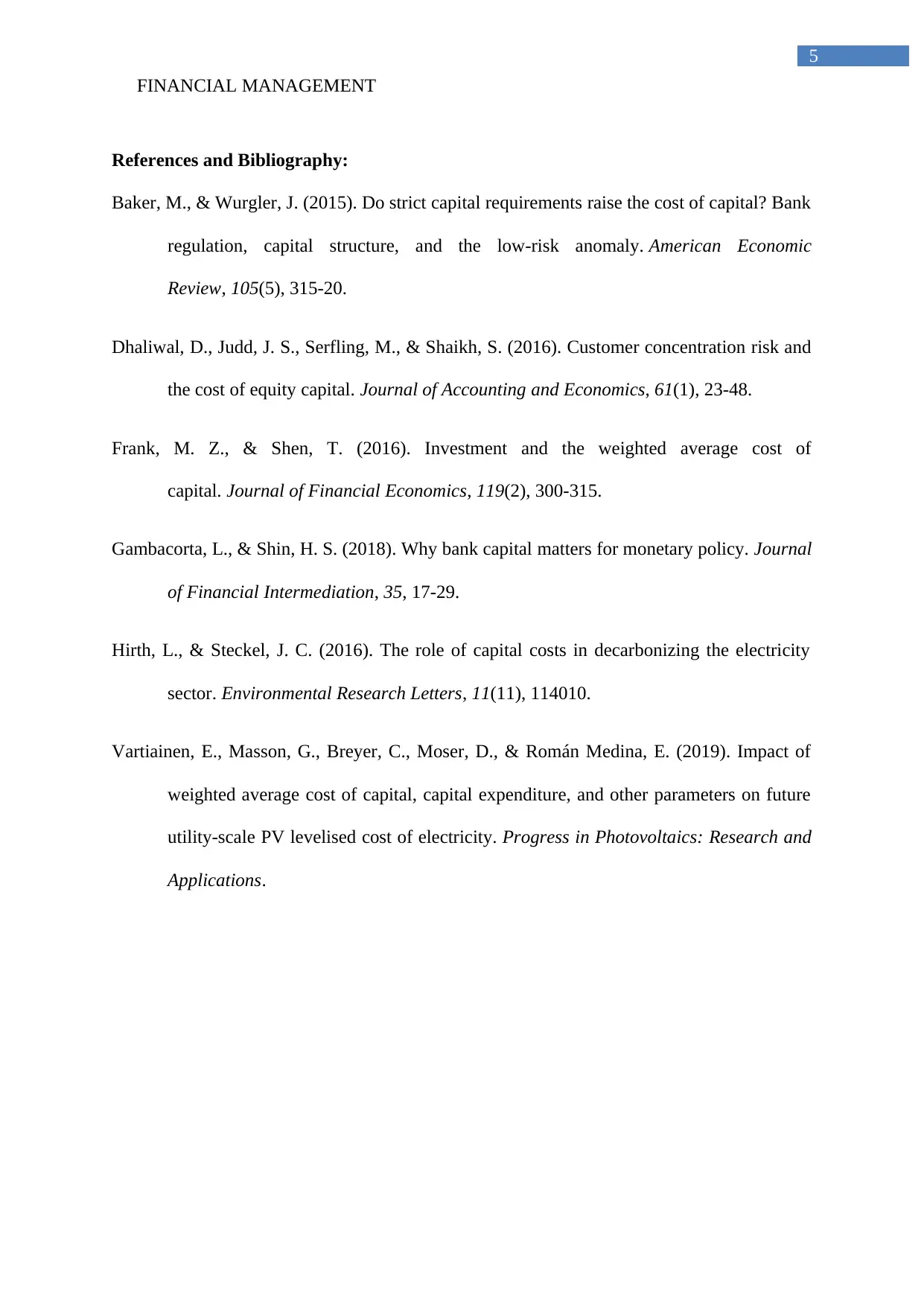
FINANCIAL MANAGEMENT
5
References and Bibliography:
Baker, M., & Wurgler, J. (2015). Do strict capital requirements raise the cost of capital? Bank
regulation, capital structure, and the low-risk anomaly. American Economic
Review, 105(5), 315-20.
Dhaliwal, D., Judd, J. S., Serfling, M., & Shaikh, S. (2016). Customer concentration risk and
the cost of equity capital. Journal of Accounting and Economics, 61(1), 23-48.
Frank, M. Z., & Shen, T. (2016). Investment and the weighted average cost of
capital. Journal of Financial Economics, 119(2), 300-315.
Gambacorta, L., & Shin, H. S. (2018). Why bank capital matters for monetary policy. Journal
of Financial Intermediation, 35, 17-29.
Hirth, L., & Steckel, J. C. (2016). The role of capital costs in decarbonizing the electricity
sector. Environmental Research Letters, 11(11), 114010.
Vartiainen, E., Masson, G., Breyer, C., Moser, D., & Román Medina, E. (2019). Impact of
weighted average cost of capital, capital expenditure, and other parameters on future
utility‐scale PV levelised cost of electricity. Progress in Photovoltaics: Research and
Applications.
5
References and Bibliography:
Baker, M., & Wurgler, J. (2015). Do strict capital requirements raise the cost of capital? Bank
regulation, capital structure, and the low-risk anomaly. American Economic
Review, 105(5), 315-20.
Dhaliwal, D., Judd, J. S., Serfling, M., & Shaikh, S. (2016). Customer concentration risk and
the cost of equity capital. Journal of Accounting and Economics, 61(1), 23-48.
Frank, M. Z., & Shen, T. (2016). Investment and the weighted average cost of
capital. Journal of Financial Economics, 119(2), 300-315.
Gambacorta, L., & Shin, H. S. (2018). Why bank capital matters for monetary policy. Journal
of Financial Intermediation, 35, 17-29.
Hirth, L., & Steckel, J. C. (2016). The role of capital costs in decarbonizing the electricity
sector. Environmental Research Letters, 11(11), 114010.
Vartiainen, E., Masson, G., Breyer, C., Moser, D., & Román Medina, E. (2019). Impact of
weighted average cost of capital, capital expenditure, and other parameters on future
utility‐scale PV levelised cost of electricity. Progress in Photovoltaics: Research and
Applications.
⊘ This is a preview!⊘
Do you want full access?
Subscribe today to unlock all pages.

Trusted by 1+ million students worldwide
1 out of 6
Related Documents
Your All-in-One AI-Powered Toolkit for Academic Success.
+13062052269
info@desklib.com
Available 24*7 on WhatsApp / Email
![[object Object]](/_next/static/media/star-bottom.7253800d.svg)
Unlock your academic potential
Copyright © 2020–2025 A2Z Services. All Rights Reserved. Developed and managed by ZUCOL.





